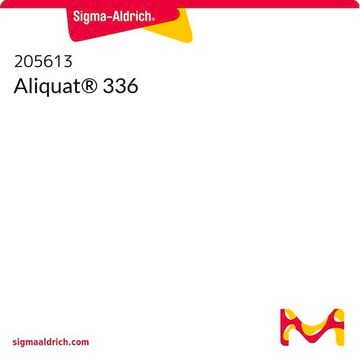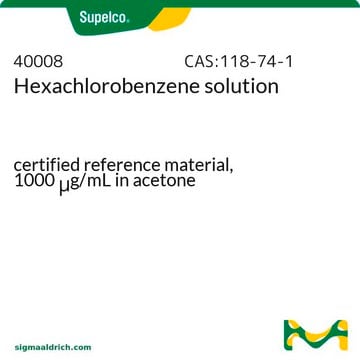131326
Pentachlorobenzene
96%
Synonym(s):
1,2,3,4,5-Pentachlorobenzene
Sign Into View Organizational & Contract Pricing
All Photos(3)
About This Item
Linear Formula:
HC6Cl5
CAS Number:
Molecular Weight:
250.34
Beilstein:
1911550
EC Number:
MDL number:
UNSPSC Code:
12352100
PubChem Substance ID:
NACRES:
NA.22
Recommended Products
Assay
96%
form
solid
bp
275-277 °C (lit.)
mp
84-87 °C (lit.)
density
1.609 g/mL at 25 °C (lit.)
functional group
chloro
SMILES string
Clc1cc(Cl)c(Cl)c(Cl)c1Cl
InChI
1S/C6HCl5/c7-2-1-3(8)5(10)6(11)4(2)9/h1H
InChI key
CEOCDNVZRAIOQZ-UHFFFAOYSA-N
Looking for similar products? Visit Product Comparison Guide
Related Categories
General description
Pentachlorobenzene was determined in the water samples by packed sorbent (MEPS) coupled directly to programmed temperature vaporizer-gas chromatography-mass spectrometry.
Application
Pentachlorobenzene was used to prepare tetrachlorobenzene by photolysis.
Signal Word
Danger
Hazard Statements
Precautionary Statements
Hazard Classifications
Acute Tox. 4 Oral - Aquatic Acute 1 - Aquatic Chronic 1 - Flam. Sol. 1
Storage Class Code
4.1B - Flammable solid hazardous materials
WGK
WGK 3
Flash Point(F)
Not applicable
Flash Point(C)
Not applicable
Choose from one of the most recent versions:
Already Own This Product?
Find documentation for the products that you have recently purchased in the Document Library.
Customers Also Viewed
Gloria Grueiro Noche et al.
Analytical and bioanalytical chemistry, 405(21), 6739-6748 (2013-06-20)
A fully automated method consisting of microextraction by packed sorbent (MEPS) coupled directly to programmed temperature vaporizer-gas chromatography-mass spectrometry (PTV-GC-MS) has been developed to determine the 12 chlorobenzene congeners (chlorobenzene; 1,2-, 1,3-, and 1,4-dichlorobenzene; 1,2,3-, 1,2,4-, and 1,3,5-trichlorobenzene; 1,2,3,4-, 1,2,3,5-
Synthesis of bridgehead fluorides by fluorodeiodination.
Della EW and Head NJ. et al.
The Journal of Organic Chemistry, 57(10), 2850-2855 (1992)
Ewa Ł Gregoraszczuk et al.
Reproductive toxicology (Elmsford, N.Y.), 31(4), 494-499 (2011-02-08)
In the current study, we determined in vitro accumulation of hexachlorobenzene (HCBz) and pentachlorobenzene (PeCBz) in porcine ovarian follicles, the effect on steroidogenesis and the expression of enzymes responsible for steroid synthesis. Sixty percent of the HCBz and almost 100%
Alice Dvorska et al.
Environmental pollution (Barking, Essex : 1987), 156(2), 403-408 (2008-05-23)
The regional observatory Kosetice is a central European background station. Unique continuous monitoring from 1988 on is held here. POP (persistent organic pollutant) concentration values of air samples from Kosetice taken between 1996 and 2005 were statistically processed. Values of
Ott Roots et al.
Environmental science and pollution research international, 17(3), 740-749 (2009-04-08)
Passive air sampling survey of the Central and Eastern Europe was initiated in 2006. This paper presents data on toxic organic compounds such as polychlorinated biphenyls (PCB 28, 52, 101, 118, 153, 138, and 180), hexachlorobenzene (HCB), pentachlorobenzene (PeCB), hexachlorocyclohexane
Our team of scientists has experience in all areas of research including Life Science, Material Science, Chemical Synthesis, Chromatography, Analytical and many others.
Contact Technical Service













